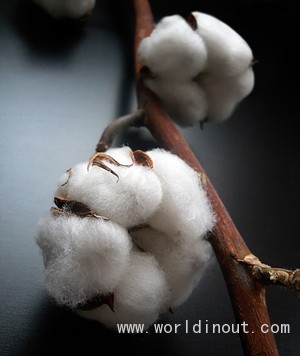
In March 2011, cotton futures traded on the Intercontinental Exchange traded to highs of $2.27 per pound. Since then, the price has moved progressively lower. In January 2015, the price of the agricultural commodity hit lows of 57.05 cents per pound.
In response to the high prices back in 2011, production increased and inventories grew. This had an extremely depressing effect on prices. In 2015, cotton traded in a range between 57.05 and 68.30 cents.
Increased supplies weighed heavily on price but demand was also weak. China is the world's number one consumer of cotton and the economic slowdown in the Asian nation caused additional weakness in cotton. China is also the world's leading producer followed by India, the United States, Pakistan, Brazil, Uzbekistan and Australia.
These seven producing nations account for around 90% of the world's cotton production. Additionally, the strong U.S. dollar caused weakness in cotton prices. The dollar is the reserve currency of the world and as such, it is the pricing mechanism for most commodities around the world, including cotton.
The World Agricultural Supply and Demand Estimates report, issued by the United States Department of Agriculture on November 10, 2015 pointed to the fact that lower cotton prices changed the behavior of growers around the world. The report lowered production estimates for India, Pakistan, Greece, Mali and Mexico. While production is falling, consumption is also slipping in China and Pakistan. According to the report, world consumption of cotton will grow by a modest 1.1% during the 2015 season, less than in previous years.
The USDA estimated world ending inventories at 106.1 million bales, six million bales lower than beginning levels.
In the United States, the USDA said in the report that the 2015/2016 season will see marginally lower production but due to less usage, ending stocks will remain unchanged. The agency lowered production by 57,000 bales as decreases in Southeast and Mississippi delta offset increases in the Southwest.
The USDA projected that domestic mill use and exports would remain unchanged from their most recent report. Cotton should trade in a range between 55 and 63 cents per pound due to the current state of market fundamentals according to the Department of Agriculture's estimate.
As of December 4, the price of active month March cotton futures was trading at the 64.7-cent level, slightly above the upper end of the agencies price range. One of the issues facing the cotton market, and other agricultural commodities, as 2015 ends and we enter 2016, is the strongest El Nino since 1997. El Nino tends to cause weather issues around the world. Given the current low price, high inventories and bearish sentiment in the world cotton market, El Nino related weather events may present surprises in terms of lower than expected production in 2016. During the second half of 2015, excessive rains in parts of Asia caused the price of rice to rise dramatically. During the third quarter of 2015, rice was the best performing commodity as the price rose by over 26% due to poor growing conditions due to weather issues.
Starting in October, the price of sugar rose dramatically due the low level of price and weather concerns due to El Nino. Sugar futures rose from lows of 10.13 cents per pound in late August all the way up to 15.85 in early December. The increase of over 56% in just over three months could be telling us something about the price of cotton in the months ahead. Although there was an oversupply condition in sugar and demand was weak, the potential for unsuitable weather conditions particularly in Brazil, the world's largest unsubsidized producer of sugar, caused a dramatic price recovery and rally in a short time.
Cotton has been under pressure since 2011. As of early December 2015, the price was less than one-third the price it had traded at just four years earlier. The conditions for a relief rally in cotton are currently present in the market and El Nino related weather issues could ignite the commodity, which has seen nothing but selling for years. Action in sugar and rice suggests that the downside in cotton could be limited and the upside explosive.






